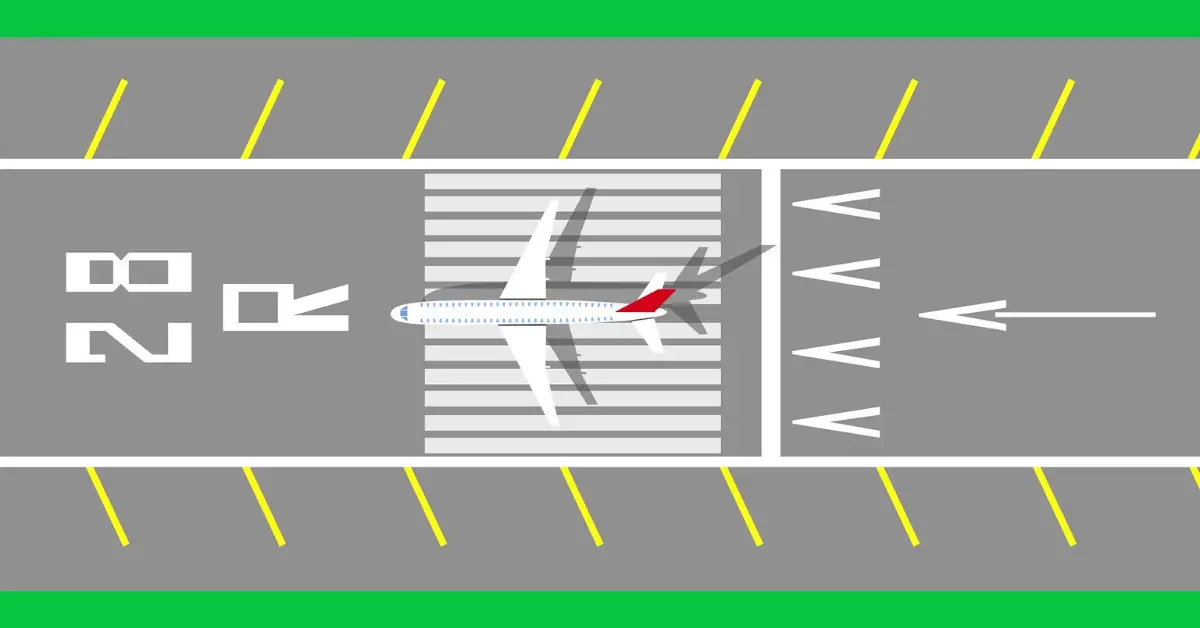Navigating the skies safely and efficiently is a marvel of modern aviation, one that relies heavily on a well-structured and universally understood system. At the heart of this system lies the ingeniously simple yet critical method of runway orientation and numbering. Understanding how the magnetic compass influences the very ground airplanes ascend from and descend to is not just crucial for pilots, but illuminating for anyone intrigued by the world of aviation.
Explore the runway’s magnetic relationship and you unlock the logic behind those seemingly arbitrary numbers. These numbers, you will find, are far from arbitrary, acting instead as crucial signposts that guide aviators during some of the most critical phases of flight.
Table of Contents
Runway Orientation and Numbering System
The Interplay of Earth’s Magnetism and Airport Runway Designations
The precise orientation of runways is an often overlooked yet crucial aspect of aviation safety and efficiency. It is the Earth’s magnetic field that acts as the cardinal guide for pilots during takeoff and landing procedures, bestowing each runway with a designation that is more than just a mere number. These numbers are inextricably linked to the magnetic azimuth of the runway about magnetic north, and as such, they serve as a universal language for pilot navigation.
Runways are numbered according to a magnetic heading rounded to the nearest whole number and truncated to the last two digits. This heading corresponds to the direction a pilot takes when using the runway. Essentially, a runway aligned to a magnetic heading of 90 degrees, pointing due east, is designated as runway 09, indicating a compass reading of 090.
Additionally, to account for reciprocal landing and takeoff, the runway’s opposite direction is labeled with the sum of 180 degrees, thus providing a separate yet adjacent number, which, in our example, would be runway 27. The magnetic orientation is not a static value; it is subject to periodic adjustments to align with shifts in the Earth’s magnetic field, which can influence navigational precision.
However, due to the dynamic nature and gradual change of the Earth’s magnetic field – a phenomenon known as magnetic variation or declination – these runway numbers occasionally require reevaluation and alteration to ensure continued concordance with magnetic bearings.
The adjustments are essential to safeguard the integrity of the aerodrome’s navigational aids and guarantee the relentless precision to which flight operations must adhere. Hence, the magnetic orientation of runways is a living testament to the symbiotic relationship between Earth’s invisible magnetic forces and the tangible structures of human aviation.

Parallel Runways and Suffixes
When addressing the configuration of parallel runways, a vital component in aerodrome infrastructure, one cannot overlook the supplementary structures these runways possess in terms of their alphanumeric identification.
For airports that are host to multiple parallel runways, which are runways aligned in the same direction and separated by a distance ensuring safe simultaneous operations, an alphabet-based suffix system is employed to differentiate between them. These suffixes, integral to a pilot’s navigational acumen, are L, C, and R, appended to the basic runway number that correlates with the magnetic azimuth.
These alphabetical designations stand for ‘Left’, ‘Center’, and ‘Right’ respectively and they signify the relative position of each runway when the pilot is approaching land or preparing for takeoff.
Thus, a runway bearing the number ’09L’ designates that it is aligned approximately 90 degrees on the magnetic compass, and is the left-most of the parallel runways when facing in the direction of landing or takeoff. The existence of these delineations is not merely for orientation but also the seamless flow of air traffic, contributing to the systematic organization that is paramount for efficient airfield operations.
The maintenance and use of these suffixes are non-trivial, as they necessitate adherence to stringent regulatory frameworks and the precise articulation of air traffic control communications.
The systematic approach to the naming conventions promotes a cooperative and lucid interaction between pilots and air traffic controllers, which is foundational to the orchestration of movements on the aerodrome surface. Additionally, the implementation and dissemination of knowledge regarding these conventions are critical to the cultivation of global aviation safety and standardization efforts.
Exploring the intricacies of runway numbering and designations reveals more than just a system of labels; it uncovers the pivotal role that magnetic orientation plays in ensuring aerial safety and order. The remarkable thought put into the suffixes of parallel runways, an essential language in the bustling hive of airfield activity, demonstrates the meticulous care in maintaining clarity for pilots and air traffic control alike.
With every takeoff and landing, the aviation industry showcases its dedication to precision and its unwavering commitment to safety, navigated by the simple yet sophisticated runway designations etched into the very tarmac beneath the aircraft.
What does runway 17 35 mean?
Runway 17/35 designates a singular runway with two opposite ends, each assigned a distinct designation based on its magnetic heading. The Runway 17 end corresponds to a magnetic heading of approximately 170 degrees, indicating a south-southeast direction. On the other hand, the Runway 35 end has a magnetic heading of approximately 350 degrees, signifying a north-northwest direction.
How do airport runways get numbered?
Airport runways are numbered based on their magnetic heading, which is the direction an aircraft would be facing when taking off or landing on that runway. The runway number is derived from the nearest 10-degree increment on the compass.
For example, if a runway points to a magnetic heading of 135 degrees, it would be designated as Runway 13. If it points to 220 degrees, it would be designated as Runway 22. If the runway has the opposite direction, the number 18 is added to the original number, so a runway with a magnetic heading of 320 degrees would be designated as Runway 32. This numbering system helps pilots easily identify and navigate runways based on their orientation.
What does runway 37 mean?
The standard airport runway numbering system does not include “Runway 37.” Runway designations typically range from 1 to 36, corresponding to the nearest 10-degree increment of the runway’s magnetic heading, which indicates the direction it faces.
What does 06 24 mean on a runway?
The numbers 06/24 on a runway refer to the magnetic headings of the two opposite ends of that particular runway. The first number (06) indicates the magnetic heading of one end, and the second number (24) indicates the magnetic heading of the opposite end.
In this context, “06” would imply that one end of the runway is oriented at approximately 60 degrees on the compass, while “24” suggests that the opposite end is oriented at approximately 240 degrees. Pilots use these numbers to determine the direction of the runway and align themselves correctly during takeoff or landing, based on their approach and the prevailing wind conditions.
Examples of Airport Runway Number System
Single Runway:
- Runway 09: This refers to a runway with a heading of approximately 90 degrees magnetic (east).
- Runway 18: This runway heads towards approximately 180 degrees magnetic (south).
- Runway 36: This runway points roughly north, with a magnetic heading close to 360 degrees.
Parallel Runways:
- Runways 15L and 15R: These two parallel runways have a magnetic heading of approximately 150 degrees. “L” and “R” denote “Left” and “Right” respectively when facing the direction of the runways.
- Runways 27C and 27L: These parallel runways point northwest with a magnetic heading of roughly 270 degrees. “C” refers to “Center” in this case.
Diagonal Runways:
- Runways 04/22: These intersecting runways have two magnetic headings: 040 degrees and 220 degrees. Pilots can use either runway depending on wind direction and landing/takeoff procedures.
- Runways 13/31: These runways intersect with headings of approximately 130 degrees and 310 degrees magnetic.
Non-Standard Runway Numbers:
- Runway 16L/34R: These runways deviate from the standard system due to changes in magnetic north. They have magnetic headings of 160 degrees and 340 degrees respectively, but are adjusted by 180 degrees for clarity.
- Runway 07/25: This runway also has adjusted numbers due to magnetic variations. Its actual headings are 197 degrees and 017 degrees.
Examples of Real Airports with Runway numbering
Single Runway:
- Runway 09: Los Angeles International Airport (LAX) – Runway 9R/27L
- Runway 18: Ronald Reagan Washington National Airport (DCA) – Runway 18/36
- Runway 36: Heathrow Airport (LHR) – Runway 36/18W
Parallel Runways:
- Runways 15L and 15R: Chicago O’Hare International Airport (ORD) – Runways 15L/33R and 15R/33L
- Runways 27C and 27L: John F. Kennedy International Airport (JFK) – Runways 27L/09R and 27R/09L
Diagonal Runways:
- Runways 04/22: San Francisco International Airport (SFO) – Runways 04L/22R and 04R/22L
- Runways 13/31: Denver International Airport (DEN) – Runways 13/31L and 13R/31R





